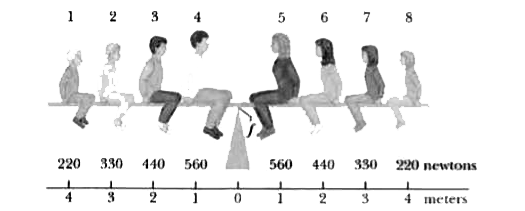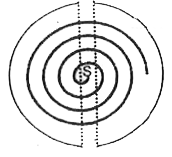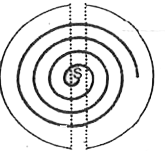A physics Brady Bunch, whose weights in newtons are indicated in Fig. is balanced on a seesaw. What is the number of the person who causes the smallest torque about the rotation axis at fulcrum f directed (a) out of the page and (b) into the page?

(a) Person 4, (b) Person 5
Topper's Solved these Questions
- RIGID BODY DYNAMICS-IIBook:RESNICK AND HALLIDAYChapter:RIGID BODY DYNAMICS-IIExercise:PRACTICE QUESTIONS
Explore 28 Videos
- RIGID BODY DYNAMICS-IIBook:RESNICK AND HALLIDAYChapter:RIGID BODY DYNAMICS-IIExercise:PRACTICE QUESTIONS (More than One Option Correct Type)
Explore 2 Videos
- RIGID BODY DYNAMICS-IIBook:RESNICK AND HALLIDAYChapter:RIGID BODY DYNAMICS-IIExercise:CHECKPOINT
Explore 4 Videos
- RIGID BODY DYNAMICS - IBook:RESNICK AND HALLIDAYChapter:RIGID BODY DYNAMICS - IExercise:PRACTICE QUESTIONS (INTEGER TYPE))
Explore 3 Videos
- TEMPERATURE, ZEROTH LAW OF THERMODYNAMICS AND THERMAL EXPANSION Book:RESNICK AND HALLIDAYChapter:TEMPERATURE, ZEROTH LAW OF THERMODYNAMICS AND THERMAL EXPANSION Exercise:PRACTICE QUETIONS (Integer Type)
Explore 4 Videos
Similar Questions
Direction: Read the following information carefully and answer the questions that follow: There are 7 persons namely A, B, C, D, E, F, and G. They all are arranged according to their weight in the descending order from left to right. B is the second lightest person. The one who is the lightest person has 65 kg of weight. Three persons have their weight between B and G. F is the heaviest of all. D has an equal number of persons who are heavier and lighter than him. D has a weight of 85 kgs. E is just heavier than B. A is heavier than C.
what is the weight of B?
View SolutionDirection: Read the following information carefully and answer the questions that follow: There are 7 persons namely A, B, C, D, E, F, and G. They all are arranged according to their weight in the descending order from left to right. B is the second lightest person. The one who is the lightest person has 65 kg of weight. Three persons have their weight between B and G. F is the heaviest of all. D has an equal number of persons who are heavier and lighter than him. D has a weight of 85 kgs. E is just heavier than B. A is heavier than C.
What is the average weight of D and C?
View Solution
Knowledge Check
To know the surface of matter on smallest scale we allow an energetic charged particle to slam into a solid target or allow two energetic charged particle to collide head on. We use cyclotrons to give very high kinetic energy to the charged particles, we arrange for the proton to circulate in a magnetic field and give it a modest electrical kick once per revolution. Two hollow D shaped objects, called does are part of an electrical oscillator that alternates the electric potential difference across the gap between the does back ad forth. the does are immersed in a magnetic field whose direction is out of the plane of page and that is set up by a large electromagnet, suppose a proton injected by a source S at the centre of the cyclotron, initially moves towards a negatively charged de. It will accelerate toward this doe and enter it. Once inside, it is shielded from electric fields by the copper walls of the dee: that is the electric field does not enter the dee. The magnetic field however is not screened by the copper dee. So, the proton moves in a circular path whose radius, which depends on speed is given by r=mvqB
The key to the operation of cyclotron is that the frequency f at which the proton circulates in the field and thaat does not depend on its speed must be equal to the fixed frequency Foce of the electrical oscillator. The resonance condition is given by
qB=2πmFoce

What is the resulting kinetic energy of deuterons?A3.99×10−12JB2.7×10−12JC1012 eVDnone of theseTo know the surface of matter on smallest scale we allow an energetic charged particle to slam into a solid target or allow two energetic charged particle to collide head on. We use cyclotrons to give very high kinetic energy to the charged particles, we arrange for the proton to circulate in a magnetic field and give it a modest electrical kick once per revolution. Two hollow D shaped objects, called does are part of an electrical oscillator that alternates the electric potential difference across the gap between the does back ad forth. the does are immersed in a magnetic field whose direction is out of the plane of page and that is set up by a large electromagnet, suppose a proton injected by a source S at the centre of the cyclotron, initially moves towards a negatively charged de. It will accelerate toward this doe and enter it. Once inside, it is shielded from electric fields by the copper walls of the dee: that is the electric field does not enter the dee. The magnetic field however is not screened by the copper dee. So, the proton moves in a circular path whose radius, which depends on speed is given by r=mvqB
The key to the operation of cyclotron is that the frequency f at which the proton circulates in the field and thaat does not depend on its speed must be equal to the fixed frequency Foce of the electrical oscillator. The resonance condition is given by
qB=2πmFoce

Suppose a cyclotron is operated at an oscillator frequency of 24 MHz and has a dee of radius 26.5 cm. Then what is the magnitude of the magnetic field needed for deuterons to be accelerated in the cyclotrons?A1.57 TB3.14 TC4.71 TDnone of theseAnalog voltmeters and ammeters work b measuring the torque exerted by a megentic field on a current carrying coil. The reading is displayed by means of the deflection of a pointer over a scale. The adjacent figure shows the essentials of a galvanometer, on which both analog ammters and analog voltmeters are based. Assume that the coil is 2.1 cm high, 1.2 cm wide has 250 turns and is mounted so that it can rotate about an axis (into the page) in a uniform radial magnetic field with B = 0.23 T. for any orientation of the coil, the net magnetic field through the coil is perpendicular to the normal vector of the coil (and thus parallel to the plane of coil) A spring SP provides a counter torque that balance the magnetic torque so that a given steady current I in the coil results in a steady angular diflection ϕ. The greater the current is greater the deflection is and thus greater the torque required of the spring is A current of 100 μA produces an angular deflection of 28∘.

What must be the torional conctant k of the spring ?A2.6×10−8 Nm/degreeB5.2×10−8 Nm/degreeC2.6×10−8 Nn/degreeD5.2×10−4 Nm/degree
Direction: Read the following information carefully and answer the questions that follow: There are 7 persons namely A, B, C, D, E, F, and G. They all are arranged according to their weight in the descending order from left to right. B is the second lightest person. The one who is the lightest person has 65 kg of weight. Three persons have their weight between B and G. F is the heaviest of all. D has an equal number of persons who are heavier and lighter than him. D has a weight of 85 kgs. E is just heavier than B. A is heavier than C.
What is the possible weight of E?
View SolutionDirection: Read the given information and answer below questions.
There are seven persons A, B, C, D, E, F and G sitting in a row facing north direction but not necessarily in the same order. Each one has a different age (in years), i.e., 4, 15, 17, 19, 21, 23 and 40 but not necessarily in the same order.
The person whose age is 19 years is sitting between C and F. F is sitting 3rd to the right of E whose age is 6 years more than that of B. A sits just immediately left of B whose age is a multiple of 5 but not more than 20. Age of F is the sum of the ages of E and G. There is only one person who sits to the immediate right of F. C whose age is a two digit prime number sits 3rd to the right of the person whose age is 4 years. Age of D is two years less than the age of G.
What is the age of F?
View SolutionThe conducting rod shown in Fig. 30-37 has length Land is being pulled along horizontal, frictionless conducting rails at a constant velocity →v. The rails are connected at one end with a metal strip. A uniform magnetic field →B, directed out of the page, fills the region in which the rod moves. Assume that L = 10 cm, v = 5.0 m/s, and B = 1.2 T. What are the (a) magnitude and (b) direction (up or down the page) of the emf induced in the rod? What are the (c) size and (d) direction of the current in the conducting loop? Assume that the resistance of the rod is 0.40 Ω and that the resistance of the rails and metal strip is negligibly small. (e) At what rate is thermal energy being generated in the rod? (f) What external force on the rod is needed to maintain →v? (g) At what rate does this force do work on the rod?
View SolutionDirections: Study the following information carefully and answer the Questions given below: Certain number of person is sitting in a row facing towards north direction. Following information is known about them:
Only two persons are sitting between H and C, who is sitting 5th to the right of B. C, is sitting 3rd from the right end. D is sitting at left most end of the row and there are only two persons sitting between D and A. F is sitting just in the middle of A and B and 2nd to the right of A. Not more than two persons are sitting between B and G and G is sitting just next to H. There are only one person is sitting between G and C.
How many persons are unknown in a row out of total members?
View SolutionThere is a four storeyed house in the neighbourhood of Rohan and Amit which has two types of staircases in it. One is a normal, stanting type staircase which is inside the house and the other one is a spiral type (vertical) staircase at the back side of the house. Both the staircases lead from the ground floor to the roof of the house. Rohan and Amit are both students of class IX in different schools. Incidently, they are both of the same weight. Rohan said that a person using slanting staircase inside the house would do more work aganist a certain 'natural force' in goind from ground floor to the roof of the house (because the distance moved by the persin in using the slanting staircase is more). Rohan also said that the work done by the same person aganist the same natural force in going from ground floor to roof of the house would be less by using the spiral type (vertical) staircase (because the distance moved by him in this case will be less). Amit, however, did not agree with Rohan. Amit said that whether this person uses slanting staircase or spiral type (vertical) staircase, work done by him aganist the natural force in goind from ground floor to roof of the house would be the same. Rohan then decided to go from the ground floor to the roof top by slanting staircase and tool 90 seconds for doing this job. On the other hand, Amit went from ground floor to the roof top by spiral type (vertical) staircase and took 2 minutes for this job.
(a) Name the natural force aganist which work has to be done in going from ground floor to the roof top of the house.
(b) What supplies energy for doing work when Rohan and Amit climb up to the roof of the house?
(c) Whose statement about the amount of work doen aganist the natural force in going from ground floor to roof top is correct and why?
(d) Who has more power in terms of physics in climbing to roof top: Rohan or Amit? Why?
(e) What value are displayed by Amit in this episode?
View Solution

